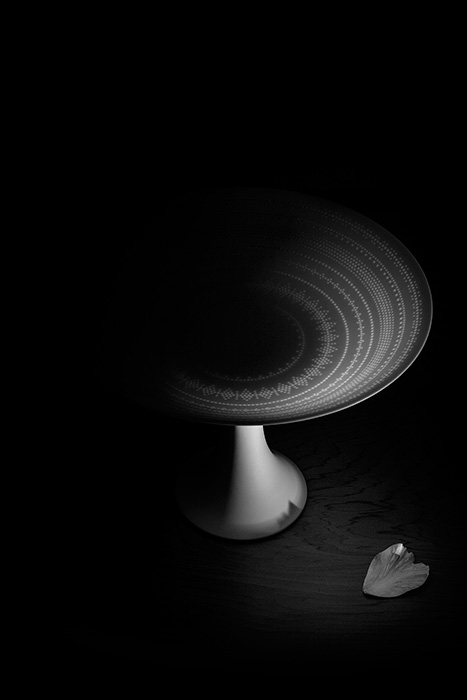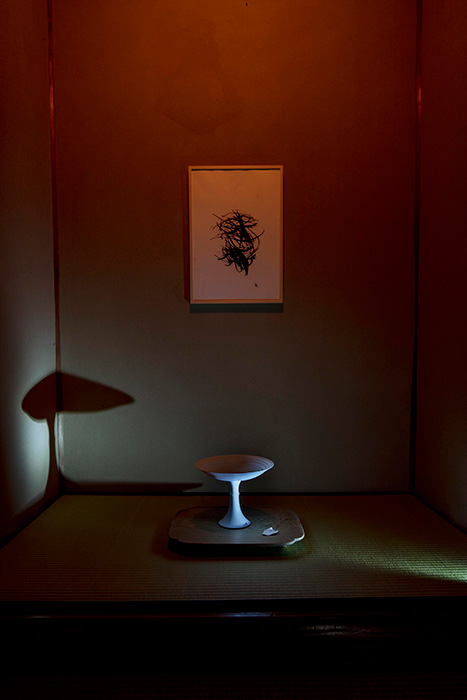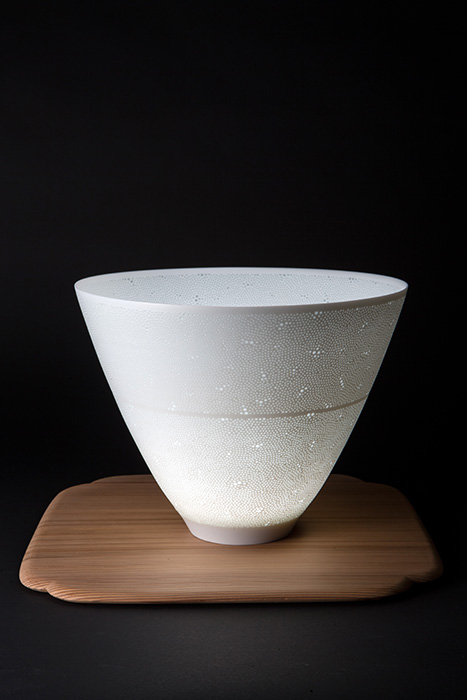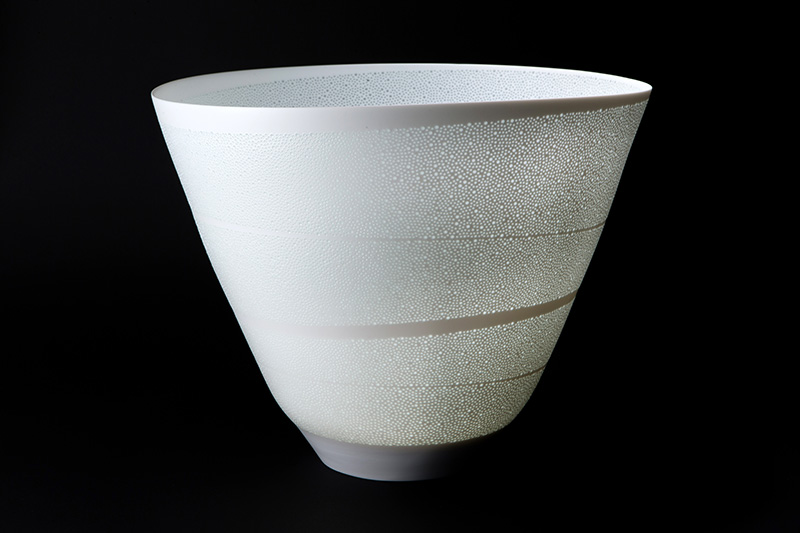2018 Artists in Residence, Museo Carlo Zauli, Faenza,Italy
The Shigaraki Ceramic Cultural Park
2017 Artists in Residence, Museo Carlo Zauli, Faenza,Italy
2011-12 Artists in Residence in Harvard Ceramic Program, MA
2001 Graduated from Tajimi city pottery and design center
Solo Exhibitions
2018 Kandori, Tokyo (’13)
2017 Kohodo Gallery, Gifu
Yokohama Takashimaya, Kanagawa
2016 Gallery Syunyo, Gifu (’05, ‘07)
Gallery Space Ohara, Tajimi
Tajimi Ishoken Gallery
Luminescent Vessels, Keiko Art International
2015 Tea Ceremony in Snow-viewing at Ubusuna House, Niigata
Savoir Vivre, Tokyo ('03, '04, '07)
Nihonbashi Mitsukoshi, Tokyo
2014 Latitude, Oriental Design Gallery, Hiroshima
Luminecsent Vessels, Roku, Tokyo Midtown, The Ritz Carlton Hotel, Tokyo
Art Gallery, Abeno Harukas, Osaka
Contemporary Ceramic-Kangori, Tokyo
Tea Ceremoney, Gallery Kurimoto, Niigata
Introspection x extrespection, Nihonbashi Mitsukoshi, Tokyo
2013 TOMIO KOYAMA Gallery, Hikarei Shibuya, Tokyo
Sogo Kobe, Hyogo
Luminecsent Vessels, Hankyu Umeda, Osaka
Tenmanya, Hiroshima
Kandori, Tokyo
Meguro Togekan, Mie
2012 KEIKO Gallery, Boston, MA
Shibuya Kuroda Toen, Tokyo
2011 Gion Konishi, Kyoto
2010 Nihonbashi Mitsukoshi, Tokyo
Kakiden Gallery, Tokyo
NIKI Gallery Satsu, Tokyo
2009 Luminous Form: Porcelain Vessels and Sculpture, KEIKO Gallery, Boston MA
2008 Tousai, Tokyo Gallery Dojima, Osaka
Akamanma, Gunma ('08)
Tenmanya, Fukuyama
2007 Oukashorin, Nagano
KoBo-Ikuko, Okayama ('05)
2006 Tousai, Tokyo
Gallery Doujima, Osaka
Kanazawa Bijutu, Ibaraki ('04)
Gallery Kurimoto, Niigata ('04)
2005 Kukansya Sirako, Tokyo
Gallery Syunyo, Gifu ('07)
2004 Gallery Kouketsu, Gifu
2003 Gallery Suki, Aichi
Group Exhibitions
2022 Ceramics of the Past and the Future: The Timelessness of Traditional Japanese Craft Arts, Panasonic Shiodome Museum of Art, Tokyo/ Japan Kōgei Association, Ishikawa
2021 The Japan Ceramics Society Award and Gold Award 2020 AKio Niisato・MIWA Kyusetsu XIII, Tokyo
Modern Crafts and Tea Utensils: Furnishings in Each Season The Third of National Crafts Museum, Ishikawa
No Man’s Land-The Future of Ceramic Art, the Unseen Beyond the Horizon- The Museum of Ceramic Art, Hyogo
DOMANI: The Art of Tomorrow Exhibition 2021 National Art Center, Tokyo
YUTAKANARU CHATO Ibaraki Ceramic Art Museum
2020 CONTEMPORARY JAPANESE CRAFTS Reinterpretation, Exquisite Craftsmanship, and Aesthetic Exploration Panasonic Shiodome Museum of Art, Tokyo
2019 Tea - happy betrayal, and play, it prays. Ryosokuin, Kyoto
Masterpieces of Modern Crafts from The Museum Collection -Special display Modern Tea Caddies- The National Museum of Modern Art, Tokyo
2018 Ottonbre Giappone Museo Carlo Zauli/ Tracce Dl Uno Scambio Faenza, Italy
2018 Decore for Tea Ceremonies in 21st century, Isezaki Koichiro, Rusu Aki, Niisato Akio, Itibata Hyakkaten, Shimane
2017 Gendai no Cyatou – Rikyu ni Misetai, Ibaraki Ceramic Art Museum, Ibaraki
2016 Museo Intenazionale delle Ceramiche in Faenza, Italy
PUNK, Rakusutei Museum, Toyama
M3- Mirai x Mitsukoshi x Musubu, Nihonbashi Mitsukoshi, Tokyo
Revalue Nippon Project: Hidetoshi Nakata’s Favorite Japanese KOGEI,Shiodome Museum, Tokyo
2015 Kikuchi Kanjitsu Exhibition, Musée Tomo, Tokyo
8 Ceramic Artists, 8/ Art Gallery/ Tomio Koyama Gallery, Tokyo
MINO, Kakiden Gallery, Tokyo
Nippon! Contemporary Arts and Crafts from Japan, ESH Gallery, Milan, Italy
Dialogue with Materials: Contemporary Japanese Arts an Crafts, Anadolu University, Eskisehir, Turkey
2014 International Japanische Progressive Keramik Trifft auf Japanische Avantgardistische Malerei, Galerie IAC-Berlin-Koigswinter and Tenri Kultur Werkstatt, Cologne
Dialogue with Materials: Contemporary Japanese Arts an Crafts, Ahmed Adnen Saygun Sanat Merkezi, Izmir, Turkey
Contemporary Ceramic Exhibition: Tomorrow for the MINO Ware, Tajimi Minoyaki Museum, Gifu
2013 La céramique Japonaise, Association Culturelle Franco-Japonaise de TENRI, Paris, Luxembourg
2012 Ceramics Now Exhibition, 3rd edition, Galateea Gallery, Bucharest, Romania
Bi no Yokana- New Generation, Takashimaya Nihonbashi, Osaka, Kyoto, Nagoya, Yokohama, Shinjuku
"Master Teabowls of Our Days", Musee Tomo, Tokyo
2011 REVALUE NIPPON PROJECT, Ibaraki Ceramic Art Museum, Ibaraki
Contemporary Kogei Art Fair, Tokyo
Art Fair Tokyo, Tokyo
Age of White, Mashiko Museum of Ceramic Art, Tochigi
Contemporary Cerami in Tokai Area: Thinking New Generation, Aichi Prefectural Ceramic Musem, Aichi
2010 About the Tea Ceremony —A Viewpoint on Contemporary Studio Crafts, The National Museum of Modern Art, Tokyo
2009 SOFA New York
2008 Taiwan International Ceramic Biennale, Tiwan Judge’s Award - International Ceramic Competition-MINO ‘08 Grand Prize- Paramita Museum: Ceramic Competition
103 Brilliant Tea Ware- Beauty of Mino, Furukawa Museum
SOFA Chicago
2007 Kikuchi Biennale, Tokyo
“Premio Faenza” 55th edition, Italy
Judge’s Award – Oribe Craft Design
2006 Sidney Myer Fund International Ceramic Competition, Australia
2005 World Ceramic Biennale 2005 ,Korea
“Premio Faenza” 54th edition, Italy
International Ceramic Festival ’05 Mino, Gifu
City of Carouge Prize , Switzerland
Judge’s Award – Oribe Craft Design
2004 Taiwan International Ceramics Biennale, Taiwan
Mino Ceramics Now, Museum of Modern Ceramics Art, Gifu
“Hijo no Objet”, The National Museum of Modern Art, Tokyo
2003 40th Asahi Ceramic Art Exhibition, Aichi
2002 International Ceramic Festival ’02 Mino, Gifu
Awards
2020 The Japan Ceramics Society Award 2020
2017 Award for Honorable Mention, U-50 INTERNATIONAL HOKURIKU KOGEI AWARDS
2015 Kikuchi Kanjitsu Award, Tokyo
2014 New Artist Award, MOA Museum of Art, Shizuoka
2009 Incentive Award, Kikuchi Biennale, Tokyo
2008 Grand Prize, Paramita Museum Ceramic Competition
Judge's Special Award, International Ceramic Festival 08, Mino, Gifu
2005 Award for the New Artist, "Premio Faenza" 54th Edition, Italy
Collections/ Public Art
Minneapolis Institute of Art
The National Museum of Modern Art, Tokyo
Ibaraki Ceramic Art Museum
Palamita Museum, Mie
MOA Museum of Arts, Shizuoka
Faenza Ceramic Museum, Italy
Ritz Carlton Hotel, Kyoto
Anadole University Museum, Eskisehir, Turkey
Press
2011 Ceramics Now, winter 2011-2012
2009 Ceramic Magazine, Hono-Geijutsu
2008 "Expressions for Ceramic Work" - Lecture at Japan Society of Oriental Ceramic Studies, The Natinal Museun of Modern Art, Tokyo
NHK, Nagoya , TV Series "Yume KoBo"
2007 Ceramic Magazine, Tsukuru-Tojiro
2006 GIFU Newspaper
The most important aspect of my porcelain Luminescent Series is light. While we can see the sources and effects of light, light itself is illusive. Although light always exists around us, at times it evokes in us something like a spiritual feeling—such as sunlight filtering through trees, light breaking through clouds, or spotlights in the theatre. Since I want people to have those experiences with my work, I began making vessels and drilled innumerable holds in the surfaces and covered them with clear glaze that fills all the holes which allows light through them. I choose the shapes of vessels so that they ‘hold the light’ and this expresses my theme of light.
In the beginning of my career I focused on the techniques of successfully creating all the small holes in my work, but in recent years I am trying to successfully express tranquility, purity, like sunbeams through the branches of trees in the forests around Shinto shrines. Therefore the shapes of my vessels tend to be much more simple and cleaner. Although these simple forms and clean lines often give the impression of industrial design, they are very important for expressing my concepts.
While the white Luminescent vessels are considered my signature work, since 2013 I have been creating colored pieces, but the glaze of these pieces does not fill the holes. With so many unfilled small holes, at a distance an interesting moire pattern appears on the surface. Another important theme of my Luminescent Series is Transience and the colored pieces are linked to this same concept because the moire effect seems to make the patterns on the surface constantly change, depending on the view from different angles. The colored glazes strengthen the shapes of those vessels, but so many unfilled holes in the moire pattern weaken their strength, and therefore their longevity or existence is precarious. I want to explore further the balance between these two contrasting concepts.
I am also very interested in the contrast between simplicity and chaos. Piercing so many holes in the surfaces of these works is an intense process (one might even say chaotic), yet the finished pieces have a very tranquil quality. I want to express this dichotomy in my work.







